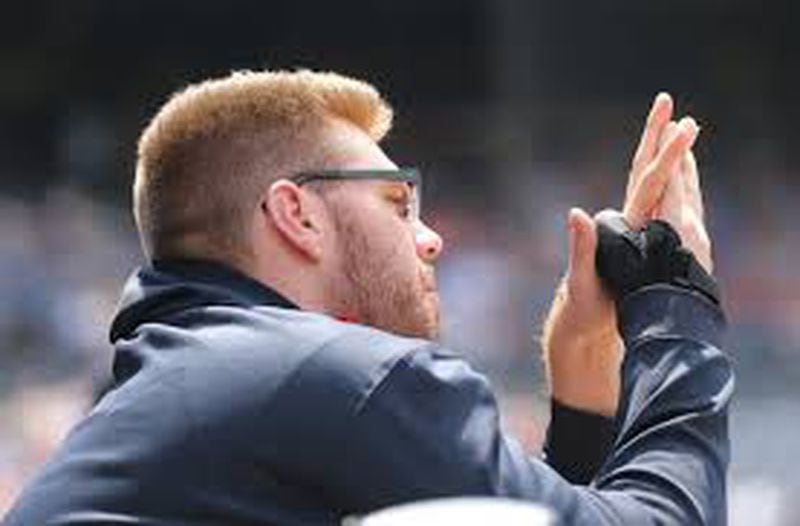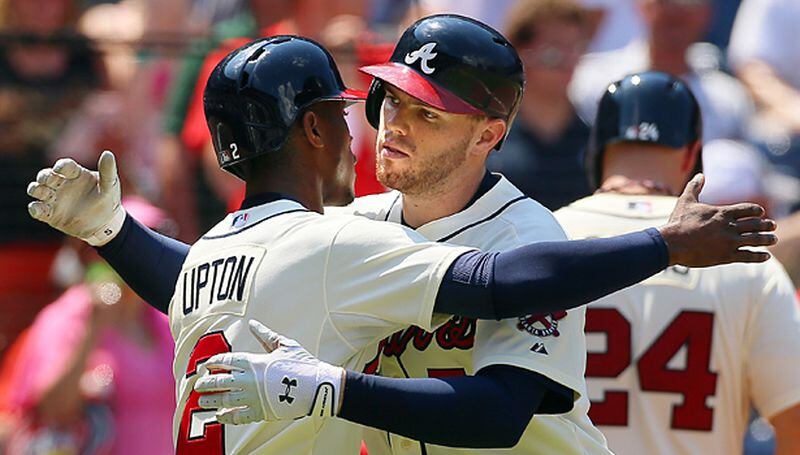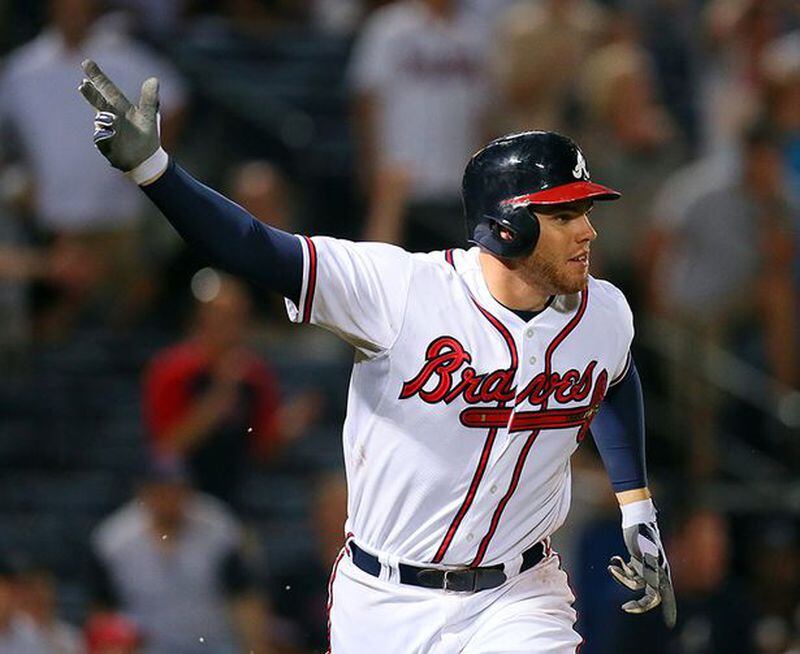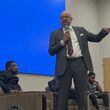They added elite pitching prospects and a solid major league outfielder through a couple of major trades this winter, but the Braves’ most significant development regarding the 2017 season might well have taken place Thursday without only a couple of people watching in an indoor batting cage at Turner Field.
That’s where first baseman Freddie Freeman hit 25 balls off a batting tee without any discomfort in his right wrist, something the Braves’ best hitter hadn’t been able to do since injuring the wrist in mid-June. He was hindered for the rest of the season and had two stints on the disabled list, and Freeman still had discomfort and concern about the wrist a month into the offseason.
“Nice to finally swing a bat with no pain after seven months,” he said following Thursday’s tee session, which had followed pain-free sessions of 25-30 “dry swings” (no baseballs involved) Tuesday and earlier Thursday.
With all the personnel changes the Braves made over the past 14 months, having Freeman healthy for a full season – he played more innings than anyone else in the majors in 2014 and set a franchise record – is particularly important in 2016, when they’ve vowed to avoid another 95-loss debacle like the one they had in 2015, and to establish some momentum before they move into a new ballpark in 2017.
It’s also important for Freeman, who prides himself on durability and steady play and wants to be a guy the Braves know they can rely on. He signed the largest contract in franchise history in February 2014, an eight-year, $135 million deal that runs through 2021 and includes salaries of $20.5 million or more over its final five years.
After trading away Jason Heyward, Justin Upton and Evan Gattis following the 2014 season, the Braves matched their sorry team scoring total from that season in 2015, but were the lowest-scoring team in the majors. This despite a resurgent season from 38-year-old catcher A.J. Pierzynksi, who ranked among major league offensive leaders at his position in several categories.
The Braves expect improvement from several young players and are optimistic about the impact that offseason additions Ender Inciarte and Erick Aybar can have on their offense. But everyone knows, to be a significantly improved offensive team they need to keep Freeman in the lineup, healthy and back to his pre-injury productivity.
In the Braves’ first 66 games through June 17, Freeman hit .299 with 12 homers, 41 RBIs and a .367 OBP and whopping .520 slugging percentage. He was on pace for 49 doubles, 29 homers, 100 RBIs and 105 runs.
But he hurt his wrist and landed on the DL, and Freeman played in only 52 of the Braves’ 96 games the rest of the season, batting .241 with seven doubles, six homers, 19 runs, 25 RBIs and a .395 slugging percentage.
The Braves, after averaging 4.29 runs per game through June 17, averaged 3.02 runs the rest of the season.
I talked with Freeman this week about his wrist, the team's wholesale changes and rebuilding effort over the past 15 months, and his attitude going forward. The first of three parts of the interview ran here Thursday, with Freeman discussing his wrist and how it finally felt pain-free following another recent injection.
In today’s second part, he discusses upcoming spring training and some things he’s done this winter after the rough 2015 season.
Q. Spring training can be tough coming off such an injury, going from offseason to swinging hundreds of times a day, right? If you don’t ease into it a little?
A. Yeah, I think that’s what we’re going to do. I think we’re going to take it easy. It’s kind of a weird injury in that it only hurt when I’d like, open bottles or turn door knobs, or obviously when I swung. But I could work out and if I kept my wrist straight and didn’t curl it or anything I had no problem. So I’ve been working out every day pretty much, and I still have all my strength, because you’re still active and you’re bench-pressing and everything like that. But I’m going to start doing wrist curls to get all those little muscles in my forearm strong again, and hopefully I can build up enough to where I don’t miss any time in spring training. But if I do it’s only going to be, like, a couple of days. I should be almost 100 percent ready to go by spring training.
Has Dan Uggla given you his wrist-curl program? (Freeman and former Brave Uggla are close friends.)
(Freeman laughter.) I work out with him five days a week, so…. I don’t know if I’ll ever get the Dan Uggla build, but I’m going to try.
He probably can’t sympathize with anyone having wrist problems, with those wrist and forearms that he has.
I know, he’s got the biggest ones in the game. He’s doing well also. He hasn’t signed (with any team) yet. With these free-agent guys still out there, they’re still trying to figure out that market. I think it’ll come down to the last few days before spring training until he signs with a team. It’ll be a minor league deal like he got last year, but he’s just looking for an opportunity to prove to himself that he can do it again.
Have you been doing a lot of swimming? Have you always done that? I saw the picture that your wife posted on Twitter.
Yeah, I’ve always been able to do that when I lived in California. But obviously with the winters here in Atlanta it’s kind of tough to do that. But we went on vacation (to Turks and Caicos (SIC?)) to get out of the cold and I swam laps every single day down there, just to get everything fired up, just to do the whole body because when you’re on vacation you don’t really work out that much. I wanted to keep it going because I feel strong, I feel healthy, and I didn’t want to lose anything when I went on vacation for a week.
Had you really done 200 laps to that point in the workout, as she said in the Tweet with the photo?
Yeah, it only took, like, 14 strokes to get from one side to the other (in the pool). I got in the pool at, like, 5:45 (p.m.) and I got out at 7:15. It was kind of a nice view, so I didn’t want to get out.
Damn, were you a swimmer as a kid?
Not really. I just was in the pool a lot. My grandparents had a pool. I just kind of hung out and picked it up from watching people.
By the way, who said something about feeling no pain the wrist while moving? Hopefully it was your own move.
Yeah, we moved from Roswell to inside the Perimeter. I was just picking up boxes and everything. It was kind of tough because the first day I was, like, I don’t know if I can do all this, picking up all the boxes and everything. But it was just a matter of a day where it just changed and I had no pain. It was crazy.
The 2015 season had to be tough for you, going from starting all 162 games the year before and playing almost every inning of the season, to not being able to stay on the field this past season. And people are saying, “He can’t stay on the field” even though you played the most innings in the majors the year before.
Yeah, that was the toughest part. Obviously it’s “what have you done for me now” in this game. It’s just tough personally, because my goal every year is to play every game. And it just came to the point where I just couldn’t physically do it. And even if I could stay on the field I wasn’t helping the team when I was out there. Even in the second half I wasn’t the same player. It’s super frustrating, but I think I came to the realization now, I know what playing through pain is and what injury pain is, and that’s what I found out last year in the second half. I just couldn’t play through that. I was hurting myself more and hurting the team by being out there, being stubborn and trying to play and help the team. But it was tough, because until I got hurt in June I was on pace to have one of my best years. And that was the most frustrating thing for me, that all of a sudden I take a funky swing and it derails my whole season. So hopefully it doesn’t happen again this year. Hopefully I’ve got it healthy and I can strengthen up my wrist muscles and stop it from happening for the next few years.








